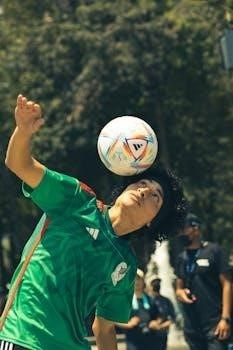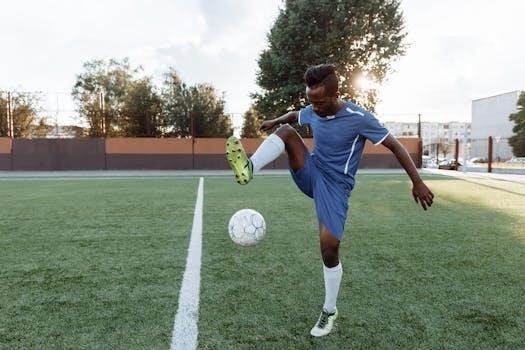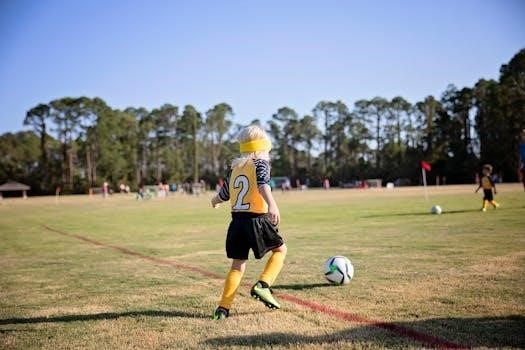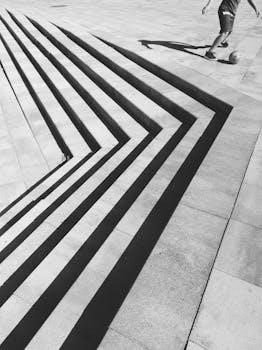Selecting the right size soccer ball is crucial for young players’ development and enjoyment of the game. Different age groups require specific ball sizes to match their physical abilities and skill levels. This guide aims to help parents and coaches choose the appropriate ball for youth soccer.
Importance of Correct Ball Size
Using the correct soccer ball size is paramount for young players’ safety, skill development, and overall enjoyment of the game. An inappropriately sized ball can hinder a child’s ability to learn proper techniques and can even lead to injuries. For instance, a ball that is too large or heavy can strain young muscles, while a ball that is too small can impede the development of proper kicking and control skills. Correct ball size allows children to develop proper footwork, ball control, and kicking technique, which are fundamental to soccer mastery. It also ensures that the weight and size of the ball are suitable for their physical capabilities, minimizing the risk of strain or injury. A properly sized ball promotes confidence and makes the game more engaging, encouraging young athletes to participate actively and develop a passion for soccer. The right ball allows for a more fluid and enjoyable learning experience, helping young players progress more effectively and build a strong foundation for their future soccer endeavors. Ultimately, choosing the appropriate size is about supporting their growth and nurturing their love for the sport.

Soccer Ball Size by Age Groups
Soccer ball sizes are categorized by age, ensuring that young players use equipment that matches their physical abilities. This section details the recommended ball sizes for each age group, from toddlers to teenagers, providing guidance for proper selection.
Size 1⁚ For All Ages, Skill Development

Size 1 soccer balls, often referred to as “skill balls,” are unique in that they aren’t specifically tied to a particular age group. Instead, they are designed for players of all ages who want to hone their ball control, footwork, and technical abilities. These smaller balls, typically measuring around 18 to 20 inches in circumference, are excellent tools for individual practice and skill development drills. Their reduced size and weight make them easier to manipulate, allowing players to focus on precision and control. Unlike other ball sizes, which are mainly used in team play, the size 1 ball is perfect for personal training.
The versatility of the size 1 ball makes it a valuable addition to any soccer player’s training regimen. It’s not just for beginners; advanced players also use them to refine their touch and agility. Whether you’re a toddler just learning to kick or an experienced player working on complex maneuvers, the size 1 ball can help improve your overall game. Additionally, these balls are often used as souvenirs for events, further highlighting their diverse appeal and use beyond traditional gameplay. They promote better coordination and a more intricate understanding of the ball, benefitting players of all levels.
Size 2⁚ Ages 3-5 Years
Size 2 soccer balls are specifically designed for children aged 3 to 5 years, marking an introduction to the game for this age group. With a circumference of approximately 20 to 22 inches and a weight ranging between 250 and 280 grams, these balls are smaller and lighter, making them easier for young children to handle and control. This size is crucial for developing basic motor skills and coordination, allowing these young players to comfortably learn the fundamentals of soccer without being overwhelmed by a ball that’s too large or heavy. The reduced weight and size promote success and enjoyment for beginners, which is essential for continued engagement.
Despite being the recommended size for this age group, size 2 balls are not as commonly used in many youth soccer programs. Many programs often default to size 3 as their smallest ball, even though the standard guidelines advocate for size 2 for 3 to 5-year-olds. This highlights the importance of understanding the recommended guidelines to ensure that children are using age-appropriate equipment. Using a size 2 ball allows these young players to develop their skills without struggling with a larger ball, fostering a positive and confident start to their soccer journey. The lighter weight encourages easier kicking and better overall control, building a solid foundation for future skill development.
Size 3⁚ Ages 5-8 Years
Size 3 soccer balls are designed for children aged 5 to 8 years, representing a crucial step in their soccer development. These balls typically have a circumference of 23 to 24 inches, making them larger than size 2 but still manageable for young players. This size allows children to enhance their skills as they begin to understand team dynamics and more complex soccer techniques. The size 3 ball is often considered the most common size found in youth soccer, as it is ideal for this age group’s physical capabilities and skill-building needs. It serves as the primary ball for most junior games and training sessions, providing a platform for young athletes to refine their footwork and ball control.
The size 3 ball’s dimensions are perfectly suited to help players get comfortable with the game’s fundamentals while fostering a sense of teamwork. Its weight and size promote easier kicking and handling, contributing to a smoother learning experience. As children in this age range are getting accustomed to team sports, the size 3 ball is designed to help them embrace the camaraderie and team-oriented aspects of soccer. This ball is not only a training tool but also an instrument for creating a positive and engaging experience for the young athletes, encouraging their passion for the game. Choosing the appropriate size ensures they can develop their skills and enjoy the game without any unnecessary challenges.
Size 4⁚ Ages 8-12 Years
Size 4 soccer balls are specifically designed for youth players aged 8 to 12 years, marking a significant transition in their soccer journey; These balls typically have a circumference of 25 to 26 inches and weigh between 350 and 390 grams, making them larger and heavier than size 3 balls. This increase in size and weight is essential for players in this age group as they develop more strength and refine their skills. The size 4 ball is often referred to as the “youth ball” and is a standard choice for most youth leagues and competitions.
The dimensions of the size 4 ball are beneficial for players in this age group as they are now developing more advanced kicking techniques and stronger ball control. This size ball allows players to get accustomed to a more standard ball size that is closer to the official size used in older age groups. For players aged 8 to 12, a size 4 soccer ball is the most appropriate, as they have developed enough strength and skill to handle it effectively. This ball size is designed to support their skill development, including more precise passing and more powerful shots, while also preparing them for the transition to larger ball sizes in the future. Choosing the appropriate ball ensures they can develop their skills without any unnecessary challenges.
Size 5⁚ Ages 13 and Up
Size 5 soccer balls are the standard for players aged 13 and older, including adult and professional leagues. This size is the largest and heaviest of the standard soccer ball sizes, designed to match the physical development and playing style of older athletes. The official size 5 ball typically has a circumference of 27 to 28 inches and weighs around 410 to 450 grams, making it significantly larger and heavier than the size 4 ball used by younger players. Players transitioning to size 5 balls have typically developed the necessary strength and technique to manage the increased size and weight effectively.
The size 5 ball is the official size used in most soccer competitions worldwide, and it is specifically tailored to the strength, agility, and playing styles of adult athletes. Its larger size and heavier weight require more developed kicking techniques and greater power for passes and shots; For players aged 13 and up, the size 5 ball is essential as it prepares them for competitive play at higher levels. Choosing the right ball size is crucial for performance and player development, ensuring they can execute their skills effectively. The transition to size 5 signifies an important milestone in a soccer player’s journey, marking their entry into more competitive and advanced play.

Key Considerations When Choosing a Soccer Ball
When selecting a soccer ball for young players, several key factors should be considered. These include the ball’s circumference, weight, material, and construction. These elements ensure the ball is appropriate for the player’s age, skill level, and safety.
Circumference and Weight Specifications
The circumference and weight of a soccer ball are critical factors that directly influence a young player’s ability to control and manipulate the ball effectively. For instance, a size 2 ball, often used for the youngest players aged 3-5, typically has a circumference of 20-22 inches and weighs between 250-280 grams. This smaller size and lighter weight make it easier for toddlers to handle. As children grow, the ball size increases accordingly. A size 3 ball, ideal for ages 5-8, measures around 23-24 inches in circumference. The size 4, designed for players aged 8-12, has a circumference of 25-26 inches and weighs between 350-390 grams. This increase is important as it is more suitable for their growing strength and skills. Finally, a size 5 ball, used by players 13 and older, has a circumference of approximately 27-28 inches and a weight of 410-450 grams, aligning with the physical maturity of older players. The right weight and circumference ensure that the ball is not too heavy or large for young players, allowing them to develop their technique without struggling. Adhering to these specifications is key to promoting skill development and safe play.
Material and Construction for Youth Balls
The material and construction of youth soccer balls are essential for ensuring durability, performance, and safety. Typically, youth soccer balls are made from synthetic materials such as polyurethane (PU) or polyvinyl chloride (PVC), which offer a good balance between softness, resilience, and water resistance. PU is often preferred for higher-quality balls due to its softer feel and improved durability, making it more comfortable for young players to kick and control. PVC is a more affordable option, commonly used for recreational or training balls. The construction of the ball involves multiple layers, including an outer casing, a lining, and an internal bladder. The lining provides shape retention and added durability, while the bladder, usually made of butyl or latex, holds the air. Butyl bladders retain air better over time, while latex bladders offer a softer feel but may require more frequent inflation. The stitching or bonding of the panels is also important. Machine-stitched balls are more common and affordable, while hand-stitched balls offer improved durability and a more consistent flight path. For youth soccer, it’s crucial to choose balls with softer materials and durable construction to promote player comfort and ensure they can withstand regular use. These factors significantly impact the ball’s feel, performance, and longevity.

Recommendations from Organizations like US Youth Soccer
Organizations like US Youth Soccer play a crucial role in guiding the selection of appropriate soccer ball sizes for different age groups, emphasizing both safety and skill development. US Youth Soccer provides guidelines that are widely adopted by leagues and clubs across the United States. They recommend specific ball sizes based on age, ensuring that young players are using equipment that is suitable for their physical capabilities. For instance, US Youth Soccer typically advises the use of a size 3 soccer ball for children under 8 years old, which is often considered the standard for junior play. This size is smaller and lighter, making it easier for younger children to handle and kick. For the 8-12 age group, they recommend a size 4 soccer ball, which is slightly larger and heavier, allowing players to develop their skills and strength more effectively. Finally, for players aged 13 and above, US Youth Soccer aligns with the standard adult size 5 soccer ball. These guidelines are not just arbitrary; they are designed to ensure that players are using balls that are proportional to their size, allowing them to develop proper techniques and prevent injuries. These recommendations help in creating a structured and consistent approach to youth soccer.
